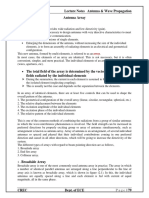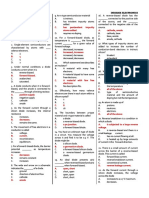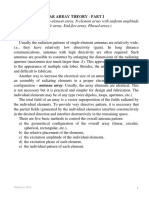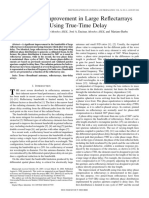Lecture Notes-Antenna Arrays
Uploaded by
Eng Burhaanudiin CumarLecture Notes-Antenna Arrays
Uploaded by
Eng Burhaanudiin CumarNUS/ECE
EE4101
Antenna Arrays
1 Introduction
Antenna arrays are becoming increasingly important in
wireless communications. Advantages of using antenna
arrays:
1. They can provide the capability of a steerable beam
(radiation direction change) as in smart antennas.
2. They can provide a high gain (array gain) by using
simple antenna elements.
3. They provide a diversity gain in multipath signal
reception.
4. They enable array signal processing.
Hon Tat Hui
Antenna Arrays
NUS/ECE
EE4101
An important characteristic of an array is the change of its
radiation pattern in response to different excitations of its
antenna elements. Unlike a single antenna whose radiation
pattern is fixed, an antenna arrays radiation pattern, called
the array pattern, can be changed upon exciting its elements
with different currents (both current magnitudes and current
phases). This gives us a freedom to choose (or design) a
certain desired array pattern from an array, without changing
its physical dimensions. Furthermore, by manipulating the
received signals from the individual antenna elements in
different ways, we can achieve many signal processing
functions such as spatial filtering, interference suppression,
gain enhancement, target tracking, etc.
Hon Tat Hui
Antenna Arrays
NUS/ECE
EE4101
2 Two Element Arrays
z
Far field
observation
point
r1
Dipole 2
I 2 Ie j
d
Dipole 1
I1 I
r1 r d cos , 0
Two Hertzian dipoles of length d separated by a distance
d and excited by currents with an equal amplitude I but a
phase difference [0 ~ 2).
Hon Tat Hui
Antenna Arrays
NUS/ECE
EE4101
E1 = far-zone electric field produced by antenna 1 =
E2 = far-zone electric field produced by antenna 2 =
a E1
a E2
kI1d e jkr
kd e jkr
sin j
cos I1
E1 j
4 r
2
4 r
kI 2 d e jkr
kd e jkr
sin j
cos I 2
E2 j
4 r1
2
4 r1
1
Use the following far-field approximations:
1 1
r1 r
e jkr1 e jk r d cos
Hon Tat Hui
Antenna Arrays
NUS/ECE
EE4101
The total E field is:
E E1 E2 a
kd e jkr
jkd cos
a j
I
e
cos
1
2
4 r
kI1d e jkr
j jkd cos
a j
cos 1 e e
4 r
kId e jkr
a j
cos AF
4 r
where
Hon Tat Hui
Antenna Arrays
NUS/ECE
EE4101
AF Array Factor 1 e j e jkd cos
j
1 e e
jkd cos
2e
1
kd cos
2
cos kd cos
2
The magnitude of the total E field is:
I1 I 2e jkd cos
I1
jkr
kId e
E a j
cos AF
4 r
radiation pattern of a single Hertzian dipole AF
Hon Tat Hui
Antenna Arrays
NUS/ECE
EE4101
Hence we see the total far-field radiation pattern |E| of the
array (array pattern) consists of the original radiation pattern
of a single Hertzian dipole multiplying with the magnitude
of the array factor |AF|. This is a general property of
antenna arrays and is called the principle of pattern
multiplication.
When we plot the array pattern, we usually use the
normalized array factor which is:
1
1
1
AFn AF 2cos kd cos
Hon Tat Hui
where is a
constant to
make the
maximum value
of |AFn| equal
to one.
Antenna Arrays
NUS/ECE
EE4101
Examples of array patterns using pattern multiplication:
Array pattern of a two-element array of Hertzian dipoles ( = 0, and d = /4)
1
1
1
1
AFn 2cos kd cos 2cos cos
2 2
Hon Tat Hui
Antenna Arrays
NUS/ECE
EE4101
Array pattern of a two-element array of Hertzian dipoles ( = -90, and d = /4)
1
1
1
1
AFn 2cos kd cos 2cos cos
2 2 2
Hon Tat Hui
Antenna Arrays
NUS/ECE
EE4101
In many practical arrays, the element radiation pattern is
usually chosen to be non-directional, for example the -plane
pattern of a Hertzian dipole or a half-wave dipole. Then in
this case, the array radiation pattern will be totally
determined by the array factor AF alone, as shown in the
example below:
Element pattern
Hon Tat Hui
|F()| Array factor |A()| = Array pattern (normalized)
10
Antenna Arrays
NUS/ECE
EE4101
3 N-Element Uniform Liner Arrays (ULAs)
Dipoles are
parallel to the z
direction
Far field
observation
point
y
r
Dipole 1
rN-1
x
Dipole N
An N-element uniform antenna array with an element separation d
Hon Tat Hui
11
Antenna Arrays
NUS/ECE
EE4101
The principle of pattern multiplication can be extended to
N-element arrays with identical antenna elements and
equal inter-element separation (ULAs). If the excitation
currents have the same amplitude but the phase difference
between adjacent elements is (the progressive phase
difference), the array factor for this array is:
AF 1 e j ( kd cos ) e j 2( kd cos ) e j ( N 1)( kd cos )
sin N
1
j
N
2 e
2
e j ( n1)
n 1
sin
2
where kd cos and 0 , 2
Hon Tat Hui
12
Antenna Arrays
NUS/ECE
EE4101
The normalized array factor is:
sin N
1
2
AFn
sin
2
where is a constant to
make the largest value of
|AFn| equal to one. Note
that is not necessarily
equal to N.
The relation between |AFn|, , d, and is shown graphically
on next page. Note that |AFn| is a period function of ,
which is in turn a function of . The angle is in the real
space and its range is 0 to 2. However, is not in the real
space and its range can be greater than or smaller than 0 to
2, leading to the problem of grating lobes or not achieving
the maximum values of the |AFn| expression.
Hon Tat Hui
13
Antenna Arrays
NUS/ECE
EE4101
|AFn( )|
= kd cos +
kd
kdcos
The relation between AFn,, d, and
Hon Tat Hui
14
Antenna Arrays
NUS/ECE
EE4101
Properties of the normalized array factor AFn:
1. |AFn| is a periodic function of , with a period of 2.
This is because
|AFn( + 2)| = |AFn()|.
2. As cos() = cos(-), |AFn| is symmetric about the line of
the array, i.e., = 0 & . Hence it is enough to know
|AFn| for 0 .
3. The maximum values of |AFn| occur when (see
Supplementary Notes):
1
(kd cos ) m , m 0,1,2,
2 2
1
( 2m )
max main beam directions cos
2 d
Hon Tat Hui
15
Antenna Arrays
NUS/ECE
EE4101
Note that there may be more than one angles max
corresponding to the same value of m because cos-1(x) is
a multi-value function. If there are more than one
maximum angles max, the second and the subsequent
maximum angles give rise to the phenomenon of grating
lobes. The condition for grating lobes to occur is that d
(disregarding the value of ) as shown below:
2nd grating lobe
Hon Tat Hui
1st grating lobe
Main lobe
16
1st grating lobe
2nd grating lobe
Antenna Arrays
NUS/ECE
EE4101
2nd grating lobe 1st grating lobe
1st grating lobe
Main lobe
2nd grating lobe
|AFn( )|
(1) When d 0.5, no
grating lobes can be
formed for whatever
value of . (2) When d
, grating lobe(s) is
(are)
formed
for
whatever value of .
(3) When 0.5 <d< ,
formation of grating
lobes depends on .
Hon Tat Hui
Visible region
kd
=kdcos
17
General conditions to
avoid grating lobes
with [0,2] and d
[0.5,]:
1.For 0 < , the
requirement is:
kd + 2
2. For < 2, the
requirement is:
kd - 0
Antenna Arrays
NUS/ECE
EE4101
4. There are other angles corresponding to the maximum
values for the minor lobes (minor beams) but these angles
cannot be found from the formula in no. 3 above.
5. When and d are fixed, it is possible that can never be
equal to 2m. In that case, the maximum values of |AFn|
cannot be determined by the formula in no. 3.
6. The main beam directions max are not related to N. They
are functions of and d only.
7. The nulls of |AFn| occur when:
n
n 1,2,3,
,
N
2
n N ,2 N ,3 N ,
2n
1
null null directions cos
( )
N
2 d
Hon Tat Hui
18
Antenna Arrays
NUS/ECE
EE4101
Note that there may be more than one angles null
corresponding to a single value of n because cos-1(x) is a
multi-value function.
8. The null directions null are dependent on N.
9. The larger the number N, the closer is the first null (n = 1)
to the first maximum (m = 0). This means a narrower
main beam and an increase in the directivity or gain of the
array.
10.The angle for the main beam direction (m = 0) can be
controlled by varying or d.
Hon Tat Hui
19
Antenna Arrays
NUS/ECE
EE4101
Example 1
A uniform linear array consists of 10 half-wave dipoles with
an inter-element separation d = /4 and equal current
amplitude. Find the excitation current phase difference
such that the main beam direction is at 60 (max = 60).
Solutions d = /4, max = 60, N = 10
main beam dirction max
Hon Tat Hui
m
2
60 cos
2 d
m2 cos 60 0.5
m2 45 360 315,
4
20
when m 1
Antenna Arrays
NUS/ECE
EE4101
Other values of corresponding to other values of m are
outside the range of 0 2 and are not included.
sin 5 cos
1
2
AFn
sin cos
2 2
10
Hon Tat Hui
21
Antenna Arrays
NUS/ECE
EE4101
4 Mutual Coupling in Transmitting Antenna Arrays
What we studies before about antenna arrays has assumed
that the antenna elements operate independently. In
reality, antennas placed in close proximity to each other
interact strongly. This interaction is called mutual
coupling effect and it will distort the array characteristics,
such as the array pattern, from those predicted based on
the pattern multiplication principle. We need to
consider the mutual coupling effect in order to apply the
pattern multiplication principle.
We study an example of a two-element dipole array. We
characterize the mutual coupling effect using the mutual
impedance.
Hon Tat Hui
22
Antenna Arrays
NUS/ECE
EE4101
Consider two transmitting antennas as shown on next
page. They are separated by a distance of d and the
excitation voltage sources, Vs1 and Vs2, have a phase
difference of but an equal magnitude. Hence if there is
no mutual coupling effect, the excitation currents also
differ by a phase difference of and have an equal
magnitude. When the mutual coupling effect is taken
into account, the two coupled antennas can be modelled
as two equivalent circuits. Now because of the mutual
coupling effect, there is another excitation source (the
controlled voltage source) in the equivalent circuit. This
controlled voltage source is to model the coupled voltage
from the other antenna.
Hon Tat Hui
23
Antenna Arrays
NUS/ECE
EE4101
Dipoles are
parallel to the z
direction
Far field
observation
point, r
Dipole 1
x
d
Dipole 2
Two coupled dipoles
Hon Tat Hui
24
Antenna Arrays
NUS/ECE
EE4101
Antenna 2
Antenna 1
Vs1
Terminal
current
I1
Zg1
Excitation
voltage
source
Coupled
voltage
I1 a
1
b1
I2 a2
Vs2
V12
Antenna
Self-impedance
25
V21
Z22
Zg2
Z11
Zg1
Hon Tat Hui
a2
b2
Vs1
Source
internal
Impedance
Vs2
Zg2
a1
b1
I2
b2
Antenna Arrays
NUS/ECE
EE4101
Z12 mutual impedance with antenna 2 excited
V12
I2
coupled voltage across antenna 1's open-circuit terminal
excitation current at antenna 2's shorted terminal
Voc12
I 2 I1 0,Vs1 0
Voc12 a
I2
Hon Tat Hui
26
c
d
Antenna Arrays
NUS/ECE
EE4101
Z 21 mutual impedance with antenna 1 excited
V21
I1
coupled voltage across antenna 2's open-circuit terminal
excitation current at antenna 1's shorted terminal
Voc 21
I1 I 2 0,Vs 2 0
I1
Hon Tat Hui
a
b
Voc21 c
27
Note that for
passive antennas,
Z12 = Z21
Antenna Arrays
NUS/ECE
EE4101
Using the mutual impedance, the coupled voltages V12
and V21 can be expressed as follows:
V12 Z12 I 2
V21 Z21I1
I1 and I2 are the actual terminal currents at the
antennas when there is mutual coupling effect. From
the antenna equivalent circuits,
Vs1 V12
I1
Z g 1 Z11
Hon Tat Hui
Vs 2 V21
I2
Z g 2 Z 22
28
Antenna Arrays
NUS/ECE
EE4101
Is1 and Is2 are the terminal currents at the antennas when
there is no mutual coupling effect.
Vs1
I s1
Z g1 Z11
Vs 2
I s2
Z g 2 Z11
Our aim is to express I1 and I2 in terms of Is1 and Is2.
Vs 2 V21
I2
Z g 2 Z 22
Vs1 V12
I1
Z g 1 Z11
I1Z 21
I s2
Z g 2 Z 22
I 2 Z12
I s1
Z g1 Z11
Hon Tat Hui
29
Antenna Arrays
NUS/ECE
EE4101
From these two relations, we can find:
I1
Z12
I s1
I s2
Z11 Z g1
Z12 Z 21
1
Z11 Z g1 Z 22 Z g 2
, I2
Z 21
I s2
I s1
Z 22 Z g 2
Z12 Z 21
1
Z11 Z g1 Z 22 Z g 2
That is:
1
I1 I s1 Z12 I s 2
D
Hon Tat Hui
1
I s1
I 2 I s 2 Z 21
D
30
Antenna Arrays
NUS/ECE
where
EE4101
Z12 Z 21
D 1
Z11 Z g1 Z 22 Z g 2
Z12
Z12
Z11 Z g1
Z 21
Z 21
Z 22 Z g 2
Now if we want to find the array pattern E on the
horizontal plane (=/2) with mutual coupling effect, then
E is just equal to the array factor (see pages 10 and 6).
1
jkd cos
Vector
E =AF I1 I 2e
magnitude, not
I1
absolute value
Hon Tat Hui
31
Antenna Arrays
NUS/ECE
EE4101
1
E I1 I 2e jkd cos
I1
1
I s1 e jkd cos
I s1 Z12 I s 2 I s 2 Z 21
I1D
1
I s1 I s 2e jkd cos Z12 I s 2 I s1e jkd cos
I1D
with Z12 Z 21
I s1
Is2
j jkd cos
j
jkd cos
j
1 e e
with
Z12 e e
e
I1D
I s1
I s1
j kd cos
j kd cos
j
Z12e 1 e
1 e
I1D
original pattern
Hon Tat Hui
additional pattern
32
Antenna Arrays
NUS/ECE
EE4101
We see that the array pattern now consists of two parts:
the original array pattern plus an additional pattern:
Z12 e j 1 e j kd cos
which has a reverse current phase - and a modified
amplitude with a multiplication of a complex number
Z12ej. Note that all parameters in the above formula
can be calculated except I1 which will be removed after
normalization. Normalization of the above formula can
only be done when its maximum value is known, for
example by numerical calculation.
Hon Tat Hui
33
Antenna Arrays
NUS/ECE
EE4101
Absolute value
Example 2
Find the normalized array pattern |En| on the horizontal plane
(=/2) of a two-monopole array with the following
parameters with mutual coupling taken into account:
I s1 1, I s 2 e j , I s1 I s 2 1, 150
d 4, 4
Z12 Z 21 21.8 - j 21.9
Z11 Z 22 47.3 j 22.3
Z g1 Z g 2 50
I s1
Hon Tat Hui
34
I s2
Antenna Arrays
NUS/ECE
EE4101
Solution
I s1 1,
Is2 e
I s1 I s 2 1
I s1 0,
As the required array pattern |En| is on
the horizontal plane, it is equal to the
normalized array factor |AFn|.
I s 2 150 2.62 rad
2
kd
4 2
Z12
Z 21
Z12
0.16 j 0.26
Z11 Z g 1 Z 22 Z g 2
Z12 Z 21
D 1
1.042 j 0.09
Z11 Z g1 Z 22 Z g 2
Hon Tat Hui
35
Antenna Arrays
NUS/ECE
EE4101
I s1
1 e j kd cos Z12 e j 1 e j kd cos
E AF
I1D
0.95 j 0.08
1 e j 2.62e j 2 cos
I1
0.16 j 0.26 e j 2.62 1 e j 2.62e j 2 cos
0.94 j 0.37
j 2 cos
1 1.14 j 0.40 e
I1
The pattern of f 1 1.14 j 0.40 e j 2 cos
next page.
Hon Tat Hui
36
is shown on
Antenna Arrays
NUS/ECE
EE4101
f 1 1.14 j 0.40 e j 2 cos
Hon Tat Hui
37
Antenna Arrays
NUS/ECE
EE4101
Normalization
The pattern of f attains the maximum value when = 180.
When = 180,
E 180
0.94 j 0.37
j 2 cos
1 1.14 j 0.40 e
180
I1
1.83
I1
Hence we normalize |E| by this factor (1.83/|I1|) to get:
Hon Tat Hui
38
Antenna Arrays
NUS/ECE
EE4101
0.94 j 0.37
1 1.14 j 0.40 e j 2 cos
I1
En
1.83
I1
0.52 1 1.14 j 0.40 e
j 2 cos
The polar plot of |En| is shown on next page.
Hon Tat Hui
39
Antenna Arrays
NUS/ECE
EE4101
En 0.52 1 1.14 j 0.40 e
Hon Tat Hui
40
j 2 cos
Antenna Arrays
NUS/ECE
EE4101
The case when there is no mutual coupling is shown below
for comparison.
1
En no mutual coupling effect 1 e j e jkd cos
where is a constant to make
the largest value of |AFn|
equal to one ( = 1.73).
Hon Tat Hui
41
Antenna Arrays
NUS/ECE
EE4101
References:
1. C. A. Balanis, Antenna Theory, Analysis and Design, John Wiley
& Sons, Inc., New Jersey, 2005.
2. W. L. Stutzman and G. A. Thiele, Antenna Theory and Design,
Wiley, New York, 1998.
3. David K. Cheng, Field and Wave Electromagnetic, AddisonWesley Pub. Co., New York, 1989.
4. John D. Kraus, Antennas, McGraw-Hill, New York, 1988.
5. Fawwaz T. Ulaby, Applied Electromagnetics, Prentice-Hall, Inc.,
New Jersey, 2007.
6. Joseph A. Edminister, Schaums Outline of Theory and Problems
of Electromagnetics, McGraw-Hill, Singapore, 1993.
7. Yung-kuo Lim (Editor), Problems and solutions on
electromagnetism, World Scientific, Singapore, 1993.
Hon Tat Hui
42
Antenna Arrays
You might also like
- Lecture 6. Transmission Characteristics of Optical Fibers - Fiber PDFNo ratings yetLecture 6. Transmission Characteristics of Optical Fibers - Fiber PDF92 pages
- Optical Communication Past Questions and SolutionsNo ratings yetOptical Communication Past Questions and Solutions25 pages
- Principle of Communications Module 1 PretestNo ratings yetPrinciple of Communications Module 1 Pretest4 pages
- ECE440 MW Chapter - 2 - EM Plane Wave Propagation PDF100% (1)ECE440 MW Chapter - 2 - EM Plane Wave Propagation PDF53 pages
- GATE Problems in Antenna and Wave PropogationNo ratings yetGATE Problems in Antenna and Wave Propogation6 pages
- A Laboratory Manual Of: Antenna & Wave PropagationNo ratings yetA Laboratory Manual Of: Antenna & Wave Propagation29 pages
- Chapter One Introduction To Antenna Systems PDFNo ratings yetChapter One Introduction To Antenna Systems PDF64 pages
- 7-8 Directivity of Circular Loop Antennas With Uniform CurrentNo ratings yet7-8 Directivity of Circular Loop Antennas With Uniform Current170 pages
- Microwave Devices and Systems: Introduction To Microwave EngineeringNo ratings yetMicrowave Devices and Systems: Introduction To Microwave Engineering66 pages
- Antenna and Wave Propagation Two Marks Question and AnswersNo ratings yetAntenna and Wave Propagation Two Marks Question and Answers13 pages
- Solution 2013 Final Exam (1) : Q.1 (A) The Number of Modes in An Optical Fiber, Having Core and CladdingNo ratings yetSolution 2013 Final Exam (1) : Q.1 (A) The Number of Modes in An Optical Fiber, Having Core and Cladding7 pages
- Lecture1 06 - 07 - 10 David Pozar Microwave Eng100% (1)Lecture1 06 - 07 - 10 David Pozar Microwave Eng29 pages
- MATLAB Solution To Microwave Engineering Pozar 4th Ed. Example 1.5No ratings yetMATLAB Solution To Microwave Engineering Pozar 4th Ed. Example 1.55 pages
- And Spacing. Broad-Side Array. End-Fire Array. Phased Array.)No ratings yetAnd Spacing. Broad-Side Array. End-Fire Array. Phased Array.)21 pages
- Electron Beam-Specimen Interactions and Simulation Methods in MicroscopyFrom EverandElectron Beam-Specimen Interactions and Simulation Methods in MicroscopyNo ratings yet
- 1.1 1.2 Antenna Measurements: 1.3.1 Friis EquationNo ratings yet1.1 1.2 Antenna Measurements: 1.3.1 Friis Equation42 pages
- Bandwidth Improvement in Large Reflectarrays by Using True-Time DelayNo ratings yetBandwidth Improvement in Large Reflectarrays by Using True-Time Delay8 pages
- Radio Wave Propagation: Anders Västberg 08-790 44 55No ratings yetRadio Wave Propagation: Anders Västberg 08-790 44 5512 pages
- Functional Symmetry and Integrals: Plot @X 3 X, 8X, 3, 3, Filling AxisdNo ratings yetFunctional Symmetry and Integrals: Plot @X 3 X, 8X, 3, 3, Filling Axisd4 pages
- Lecture 6. Transmission Characteristics of Optical Fibers - Fiber PDFLecture 6. Transmission Characteristics of Optical Fibers - Fiber PDF
- Optical Communication Past Questions and SolutionsOptical Communication Past Questions and Solutions
- ECE440 MW Chapter - 2 - EM Plane Wave Propagation PDFECE440 MW Chapter - 2 - EM Plane Wave Propagation PDF
- A Laboratory Manual Of: Antenna & Wave PropagationA Laboratory Manual Of: Antenna & Wave Propagation
- 7-8 Directivity of Circular Loop Antennas With Uniform Current7-8 Directivity of Circular Loop Antennas With Uniform Current
- Microwave Devices and Systems: Introduction To Microwave EngineeringMicrowave Devices and Systems: Introduction To Microwave Engineering
- Antenna and Wave Propagation Two Marks Question and AnswersAntenna and Wave Propagation Two Marks Question and Answers
- Solution 2013 Final Exam (1) : Q.1 (A) The Number of Modes in An Optical Fiber, Having Core and CladdingSolution 2013 Final Exam (1) : Q.1 (A) The Number of Modes in An Optical Fiber, Having Core and Cladding
- MATLAB Solution To Microwave Engineering Pozar 4th Ed. Example 1.5MATLAB Solution To Microwave Engineering Pozar 4th Ed. Example 1.5
- And Spacing. Broad-Side Array. End-Fire Array. Phased Array.)And Spacing. Broad-Side Array. End-Fire Array. Phased Array.)
- Electron Beam-Specimen Interactions and Simulation Methods in MicroscopyFrom EverandElectron Beam-Specimen Interactions and Simulation Methods in Microscopy
- 1.1 1.2 Antenna Measurements: 1.3.1 Friis Equation1.1 1.2 Antenna Measurements: 1.3.1 Friis Equation
- Bandwidth Improvement in Large Reflectarrays by Using True-Time DelayBandwidth Improvement in Large Reflectarrays by Using True-Time Delay
- Radio Wave Propagation: Anders Västberg 08-790 44 55Radio Wave Propagation: Anders Västberg 08-790 44 55
- Functional Symmetry and Integrals: Plot @X 3 X, 8X, 3, 3, Filling AxisdFunctional Symmetry and Integrals: Plot @X 3 X, 8X, 3, 3, Filling Axisd









































































